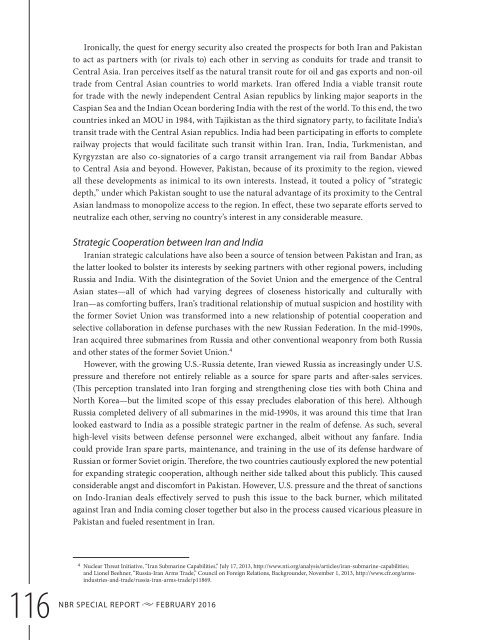pakistan’s
SR55_Mapping_Pakistan_February2016
SR55_Mapping_Pakistan_February2016
Create successful ePaper yourself
Turn your PDF publications into a flip-book with our unique Google optimized e-Paper software.
Ironically, the quest for energy security also created the prospects for both Iran and Pakistan<br />
to act as partners with (or rivals to) each other in serving as conduits for trade and transit to<br />
Central Asia. Iran perceives itself as the natural transit route for oil and gas exports and non-oil<br />
trade from Central Asian countries to world markets. Iran offered India a viable transit route<br />
for trade with the newly independent Central Asian republics by linking major seaports in the<br />
Caspian Sea and the Indian Ocean bordering India with the rest of the world. To this end, the two<br />
countries inked an MOU in 1984, with Tajikistan as the third signatory party, to facilitate India’s<br />
transit trade with the Central Asian republics. India had been participating in efforts to complete<br />
railway projects that would facilitate such transit within Iran. Iran, India, Turkmenistan, and<br />
Kyrgyzstan are also co-signatories of a cargo transit arrangement via rail from Bandar Abbas<br />
to Central Asia and beyond. However, Pakistan, because of its proximity to the region, viewed<br />
all these developments as inimical to its own interests. Instead, it touted a policy of “strategic<br />
depth,” under which Pakistan sought to use the natural advantage of its proximity to the Central<br />
Asian landmass to monopolize access to the region. In effect, these two separate efforts served to<br />
neutralize each other, serving no country’s interest in any considerable measure.<br />
Strategic Cooperation between Iran and India<br />
Iranian strategic calculations have also been a source of tension between Pakistan and Iran, as<br />
the latter looked to bolster its interests by seeking partners with other regional powers, including<br />
Russia and India. With the disintegration of the Soviet Union and the emergence of the Central<br />
Asian states—all of which had varying degrees of closeness historically and culturally with<br />
Iran—as comforting buffers, Iran’s traditional relationship of mutual suspicion and hostility with<br />
the former Soviet Union was transformed into a new relationship of potential cooperation and<br />
selective collaboration in defense purchases with the new Russian Federation. In the mid-1990s,<br />
Iran acquired three submarines from Russia and other conventional weaponry from both Russia<br />
and other states of the former Soviet Union. 4<br />
However, with the growing U.S.-Russia detente, Iran viewed Russia as increasingly under U.S.<br />
pressure and therefore not entirely reliable as a source for spare parts and ater-sales services.<br />
(This perception translated into Iran forging and strengthening close ties with both China and<br />
North Korea—but the limited scope of this essay precludes elaboration of this here). Although<br />
Russia completed delivery of all submarines in the mid-1990s, it was around this time that Iran<br />
looked eastward to India as a possible strategic partner in the realm of defense. As such, several<br />
high-level visits between defense personnel were exchanged, albeit without any fanfare. India<br />
could provide Iran spare parts, maintenance, and training in the use of its defense hardware of<br />
Russian or former Soviet origin. Therefore, the two countries cautiously explored the new potential<br />
for expanding strategic cooperation, although neither side talked about this publicly. This caused<br />
considerable angst and discomfort in Pakistan. However, U.S. pressure and the threat of sanctions<br />
on Indo-Iranian deals effectively served to push this issue to the back burner, which militated<br />
against Iran and India coming closer together but also in the process caused vicarious pleasure in<br />
Pakistan and fueled resentment in Iran.<br />
116<br />
NBR<br />
4 Nuclear Threat Initiative, “Iran Submarine Capabilities,” July 17, 2013, http://www.nti.org/analysis/articles/iran-submarine-capabilities;<br />
and Lionel Beehner, “Russia-Iran Arms Trade,” Council on Foreign Relations, Backgrounder, November 1, 2013, http://www.cfr.org/armsindustries-and-trade/russia-iran-arms-trade/p11869.<br />
SPECIAL REPORT u FEBRUARY 2016



